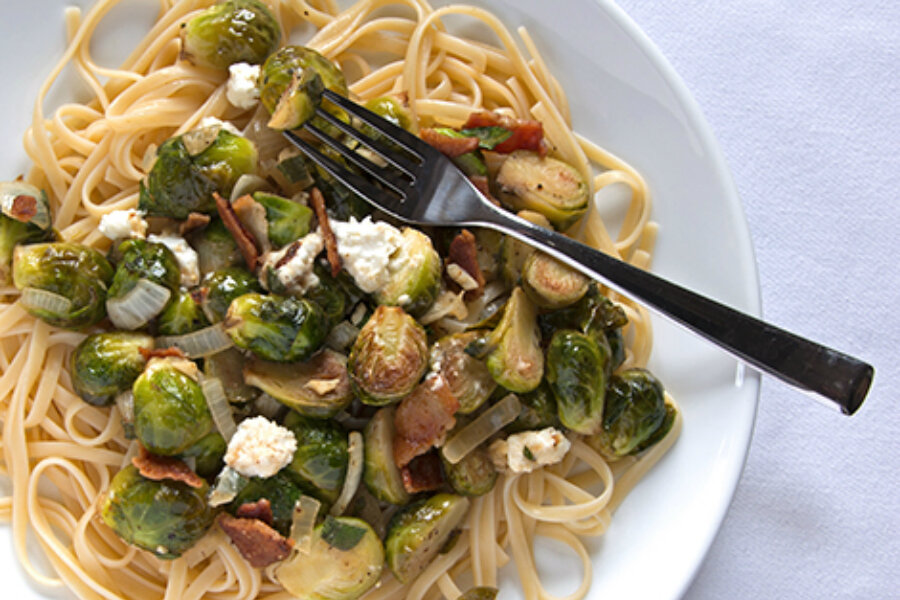Linguine with Brussels sprouts, feta, and bacon
Loading...
At my office, the creative department recently did a workshop on presentation skills. Each of us had five minutes to speak on the topic of “What I have learned.” One colleague spoke enthusiastically (to be fair, that’s her default mode of speaking) on learning to love Brussels sprouts.
Laurel probably acquired her childhood dislike for these tiny cruciferous vegetables the same way many kids did — from someone cooking them to death, stinking up the house in the process. But studies have shown that young taste buds tend to be more attuned to fats and sweets, and a taste for bitter or sour foods only develops later. So we reject all kinds of vegetables and other strong flavors, no matter how they’re prepared. Laurel overcame her fear and loathing of Brussels sprouts the way kids usually do — she grew up. She tried them again with her grownup palate and guess what, they were delicious.
This is a phenomenon I think many of us fail to recognize. Taste buds grow right along with us, if we let them. Just because you didn’t like something when you were 7 doesn’t mean you won’t like it now. The list of foods I hated as a child — or refused to even try — is an impressive one. It is a far shorter list now, and some of the most hated substances are now solidly liked. Beets, I’m looking at you.
In the case of Brussels sprouts, Laurel’s change of heart was no doubt aided and abetted by better preparation. A whole new generation of cooks has discovered these “baby cabbages” and has ditched boiling them until gummably soft for sautéing, roasting, braising, grilling and even shredding and serving raw.
For this recipe, we sautéed and braised Brussels sprouts with onion and garlic, then tossed them with bacon, crumbled feta and fresh sage, then served it all over pasta. I think Laurel would approve.
Linguine with Brussels Sprouts, Feta and Bacon
Serves 4
4 slices bacon, about 1/4 pound
1 pound Brussels sprouts, trimmed and halved (quartered, if large)
4 tablespoons olive oil—plus more, if needed
1 medium yellow onion, chopped
2 cloves garlic, minced
salt and freshly ground black pepper
1/2 cup dry white wine
1/2 cup water
1 tablespoon Dijon mustard
1-1/2 tablespoons chopped fresh sage (or 1 teaspoon dried sage)
cup crumbled feta cheese
12 ounces dried linguine (or pasta of your choice)
1. Arrange bacon in a cold, large sauté pan. Turn heat to medium and cook, turning occasionally, until just crisp. Drain on a paper towel-lined plate. Pour off bacon fat in pan, but do not wipe clean. Heat olive oil in the pan over medium flame. Add Brussels sprouts and toss to coat with oil. Season with salt and pepper and sauté for 3 to 5 minutes, turning occasionally to make sure cut sides spend quality time with the hot pan.
2. When sprouts start to brown and char a little on said cut sides, clear a space in the middle of the pan and add the onion, drizzling in more oil, if needed. Cook for about 1 minute, stirring onions occasionally, then toss sprouts and onions together. Cook for 1 minute or so, then clear another space and add garlic. Cook until fragrant, about 45 seconds, then toss everything together. Add wine and water and scrape up any browned bits. Reduce heat, partially cover pan with a lid and simmer sprouts until just cooked through and tender, 5 to 10 minutes. At the very end, clear yet another space in the center of the pan, add Dijon mustard and whisk into braising liquid. Toss to coat sprouts.
3. Meanwhile, cook the pasta. When just al dente, drain, reserving 1 cup of cooking water for this extra special cooking tip (see Kitchen Notes).
4. When pasta is cooked, remove sprouts from heat. Add bacon, sage and feta and toss just until combined. Divide pasta among shallow bowls and spoon Brussels sprouts mixture over pasta. Serve.
Kitchen Notes
Why do I need the pasta water? We are always told to not rinse cooked pasta, because it removes starches that help sauces cling. And they’re right, except… let the drained cooked pasta sit for more than a minute before serving and it seizes up into one solid mass. So return the pasta to the pot and add the pasta water—the starchy pasta water—and toss with tongs. Suddenly, the pasta is all nice individual strands again. Drain and plate immediately. You’re welcome.
Related post on Blue Kitchen: Golden beet salad








